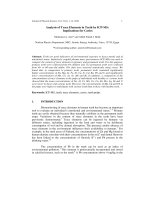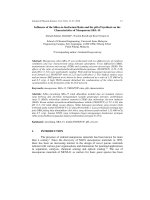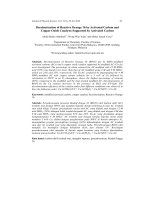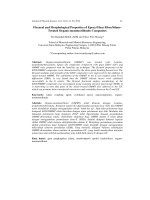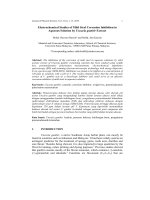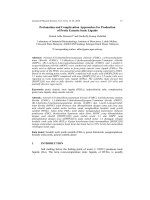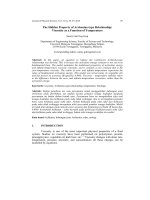Báo cáo vật lý: "Immobilization of Dithizone onto Chitin Isolated from Prawn Seawater Shells (P. merguensis) and its Preliminary Study for the Adsorption of Cd(II) Ion" pdf
Bạn đang xem bản rút gọn của tài liệu. Xem và tải ngay bản đầy đủ của tài liệu tại đây (363.72 KB, 16 trang )
Journal of Physical Science, Vol. 19(1), 63–78, 2008 63
Immobilization of Dithizone onto Chitin Isolated from Prawn
Seawater Shells (P. merguensis) and its Preliminary Study for the
Adsorption of Cd(II) Ion
Mudasir*, Ginanjar Raharjo, Iqmal Tahir and Endang Tri Wahyuni
Chemistry Department, Faculty of Mathematics and Natural Sciences, Gadjah Mada
University, Sekip Utara, P.O. Box Bls. 21, Yogyakarta 55281, Indonesia
*Corresponding author:
Abstract: Immobilization of dithizone onto biopolymer chitin isolated from prawn
seawater shells (P. merguensis) to enhance the selectivity and ability of chitin in
adsorbing heavy metal cadmium (Cd) has been conducted. The study includes isolation of
chitin from the prawn seawater, immobilization of dithizone onto chitin and adsorption of
Cd(II) ions. Several parameters influencing immobilization as well as Cd(II) adsorption
were optimized. Results of the study showed that high purity chitin polymer can be
isolated from the prawn seawater shells (P. merguensis). The best immobilization
conditions of dithizone onto chitin are achieved when the reaction is carried out for 6 h at
70
o
C in toluene medium. In general, the ability of chitin polymer in adsorbing Cd(II) ion
increases after immobilization of dithizone onto chitin. The optimum conditions for Cd(II)
adsorption are at pH 6 for chitin-dithizone and pH 7 for chitin using 0.3 g of adsorbent.
Keywords: immobilization, dithizone, chitin, cadmium(II), adsorption
1. INTRODUCTION
Aqueous effluents emanating from many industries usually contain
dissolved heavy metals such as Cd, lead (Pb), copper (Cu) and mercury (Hg).
1
If
these industrial liquid wastes are discharged without prior-treatment, they may
have an adverse impact on the environment.
2
Higher awareness of the ecological
effects of toxic metals and their accummulation through food chains has
prompted a demand for purification of industrial wastewaters prior to their
discharge into the natural water bodies and thus increasing interest has been
shown in the removal of heavy metals. Conventional methods for removing
metals from industrial waste solutions, which include chemical precipitation,
chemical oxidation or reduction, filtration, ion exchange, electrochemical
treatment, application of membrane technology and evaporation recovery are
sometime ineffective or extremely expensive, especially when the metals
dissolved are in large volumes of solution and at relatively low concentrations
(around 1–100 ppm).
3
The newly discovered metal sequestering properties of
certain types of biomass of selected bacteria, fungi, yeast, algae, higher plants,
and products derived from these organisms, offer considerable promise.
4–6
The
Immobilization of Dithizone onto Chitin 64
general term ‘biosorption’ has been used to describe a property of
microorganisms to retain toxic heavy metals from aqueous solutions.
7
The degree
of removal of heavy metals from wastewater by biosorption depends on the
multimetal competitive interactions in solution with the sorbent material.
8
Chitin is the structural polysaccharide in the exoskeleton of animals. It
is the polymer of N-acetylglucosamine, where generally <50% of the acetyl
groups has been lost. Chitin is an amide of acetic acid available in large amounts
from the shells of arthropods.
9
Its chemical structure is shown in Figure 1(a).
Chitin stoichiometry is (C
8
H
13
NO
5
)
n
and contains 6.9% nitrogen. Chitin is a high
molecular weight biopolymer of glucosamine and N-acetylglucosamine. The
applicability of this chitinous material is large considering their chemical,
physical and biological properties.
10
The chitinous materials can be used in
different forms as: flakes, powders, solutions, gels, membranes, fibres, pellets or
capsules.
11–12
One of the most important properties of chitin is its ability to
remove metal ions.
13
Their structure allows excellent complexation capacity with
metal ions, particularly transition and post-transition metals.
14
It was supposed
that the chelation of a single metal ion by several –NH− or –NHCOCH
3
groups
effectively isolates each metal ion from its neighbors.
15
Consequently, chitin may
be used in wastewater treatment for the removal of cations such as Cd ions.
9
However, the adsorption of chitin towards metal ions is not selective, especially
when alkali and alkali-earth metal ions are also available in the solution in high
level of concentrations. Therefore, modification of the chitin surface should be
carried out using a specific and sensitive ligand for heavy metal ions.
16–17
Dithizone (diphenylthiocarbazone) is a suitable ligand for such purposes because
it contains many N donor atoms, –NH as well as –SH groups which is very
specific for heavy metal ions such as Pb, Cd, Cu and Hg.
18
The purpose of this study was to immobilize an organic ligand, dithizone
[Fig. 1(b)] onto the surface of natural chitin in order to enhance the selectivity
and adsorption capacity of dithizone-immobilized natural chitin towards heavy
metal ions. The modified bioadsorbents are intended to be used for the adsorption
of heavy metals in industrial liquid waste as well as the supporting material in the
solid-phase extraction process for pre-concentration of heavy metals. Dithizone is
selected as the organic ligand in this study because it is considered to be very
selective for Hg, Cd and Pb.
18–19
The immobilization of dithizone onto the surface
of polymer
16
and silica gel
17
has been reported and successfully used for the
removal and selective pre-concentration of heavy metals. In this study, natural
biopolymer chitin was used as a supporting material for the immobilization of
dithizone, which was easily isolated from prawn seawater shells and cheaper than
synthetic polymer or silica gel.
Journal of Physical Science, Vol. 19(1), 63–78, 2008 65
SC
NH
N
N
NH
SH C
N
N
NH
N
(A)
OH
H
O
NH
H
OHH
OH
H
O
H
O
H
H
OHH
OH
H
COCH
3
O
NH COCH
3
n
SC
OH
H
O
NH
H
OHH
OH
H
O
H
O
H
H
OHH
OH
H
COCH
3
O
NH COCH
3
n
(A)(A)
(a)
(B)
NH
N
N
NH
N NH
SH C
N N
(B)(B)
Figure 1: Chemical structure of (a) chitin and (b) dithizone.
(b)
2. EXPERIMENTAL
2.1 Reagents and Materials
Metal salts of analytical grade and dithizone (1,5-diphenylthiocarbazone)
of reagent grade, were all purchased from Merck, Germany. Natural chitin was
obtained by isolating it from prawn seawater shells. Organic solvents were of
reagent grade and used as received. For all solutions, double distilled water was
used and the buffer solutions were prepared from sodium hydrogen phosphate to
which different volumes of hydrochloric acid were added, and the pH value of
the resulting solution was adjusted with the use of a pH meter.
2.2 Instrumentations
The pH measurements were carried out by a TOA pH meter model HM-
5B calibrated against two standard buffer solutions of pH 4.0 and 9.2. Infrared
spectra of biopolymer chitin and dithizone-immobilized chitin were measured
from KBr pellets by a Shimadzu FT-IR/8201 PC spectrophotometer. Metal ion
analyses were performed with a Perkin Elmer 3110 flame atomic absorption
spectrometer (AAS). X-ray diffraction analyses of chitin and dithizone-
immobilized chitin were recorded on Phillips model PW 3710 BASED X-ray
diffraction (XRD) spectrophotometer (Shimadzu 6000X, radiation source: Cu, K-
lambda 1.5402 nm).
Immobilization of Dithizone onto Chitin 66
2.3 Procedures
2.3.1 Isolation of chitin
In this research, prawn seawater shells were obtained from seafood
restaurant waste around Yogyakarta region, Indonesia. Prawn shells, which have
been boiled for 1 h and separated from its meat, were washed and depigmented
with caporite solution (4%, technical grade) for 24 h and were then dried at room
temperature (27
o
C).
Chitin was isolated from the shell of prawns using modified method
20
of
No et al.
21
consisting of deproteination and demineralization processes. Dried
prawn shells were ground and filtered through a 100 mesh filter. Deproteination
of the prawn shells was carried out by refluxing 50 g of the filtered prawn shells
with 500 ml 3.5% NaOH (w/v) for 2 h at 65ºC. The mixture was cooled and the
obtained residues were washed with water until the filtrate was neutral, which
was done by checking the filtrate with pH paper indicator. For the purpose of
demineralization, 30 g of the residues were mixed with 450 ml 1.0 M HCl and
stirred for 30 min at room temperature. The mixture was then filtered and the
solid obtained was washed with water as described above and dried at 60ºC to
yield chitin powder.
2.3.2 Characterization of biopolymer chitin
The contents of ash and total carbon in chitin have been determined by
gravimetric and volumetric methods, respectively. The nitrogen content was
determined using the Kjeldahl method. Further characterization was performed
by infrared spectroscopy for functional groups and XRD for the crystalinity using
the instrumentations as mentioned in section 2.2.
2.3.3 Immobilization of dithizone on biopolymer chitin
In order to prepare dithizone-immobilized chitin, the following procedure
was applied: 4.0 g biopolymer chitin was added to 80 ml toluene and mixed with
1.0311 g dithizone in a 500 ml flask. The mixture was refluxed and stirred for 2,
4, and 6 h at 70
o
C. The product was filtered and washed consecutively with
toluene, ethanol and water several times until the filtrate showed no characteristic
color of dithizone. The dithizone-immobilized chitin was then dried in an oven at
60
o
C for 12 h and filtered through 200 mesh filter. The dithizone-immobilized
chitin obtained was brown in color and subjected for characterization and
adsorption study.
Journal of Physical Science, Vol. 19(1), 63–78, 2008 67
2.3.4 Preliminary biosorption study of Cd(II) ion
Adsorption of Cd(II) ion from a single metal aqueous solution was
investigated in batch adsorption-equilibrium experiments. Aqueous metal ion
solutions of 25 ml containing 10 µg/ml Cd(II) ions was mixed with 0.2 g of chitin
or dithizone-immobilized chitin at room temperature and the pH of the solution
was varied in the range 3.0–8.0. The reaction mixture was mechanically shaken
for 3 h and the adsorbents were then separated from the adsorption medium. The
concentration of Cd(II) ions in the solution was determined by AAS and the
amount of adsorbed metal ions was calculated by difference using Equation (1):
16
Q = [(C
o
– C
A
) V]/m (1)
where Q is the amount of metal ions adsorbed onto unit amount of the adsorbents
(mg/g), C
o
and C
A
are the initial and final concentrations of metal ions
(µg/ml), respectively, V is the volume of the aqueous phase (ml), and m is the
weight of the chitin or chitin-dithizone adsorbents.
The effect of adsorbent mass on the amount of adsorbed Cd(II) ion was
investigated using the same procedure, but the weight of adsorbent used with 10
µg/ml Cd(II) ion solution was varied in the range of 0.05–0.5 g and the pH of the
solution was kept constant at 6.0.
3. RESULTS AND DISCUSSION
3.1 Isolation and Characterization of Chitin
Isolation of chitin from prawn seawater shells consisting of
depigmented, deproteinized and demineralized steps. Depigmentation step is
intended to remove the odor and to bleach the product so that the chitin obtained
is white in color. To avoid evaporation of water from the solution, the
deproteinizing step is carried out by refluxing the prawn shell powder in NaOH
solution. If reaction mixture is heated in an opened system, from time to time
water will be evaporated from the solution and NaOH in the solution is
concentrated, resulting in the formation of chitosan due to the deacylation process,
which may occur in the solution.
The purpose of the demineralizing step is to remove any absorbed
minerals from the surface of the chitin. This is a crucial step because the chitin
obtained will be further utilized for the adsorption of metal ions. This step is
conducted by mixing prawn shell powder with HCl solution and stirring it at
room temperature. According to Muzzarelli,
9
Ca
3
(PO
4
)
2
and CaCO
3
are the most
Immobilization of Dithizone onto Chitin 68
common minerals found as impurities in chitin. By adding HCl, these minerals
would be leached from the surface of the chitin biopolymer in accordance with
the following reaction steps:
HCI(aq) H
+
(aq) + CI
–
(aq)
(1)
(2)
Ca
3
(PO
4
)
2
(s) + 2 H
3
O
+
(aq) 3 Ca
2+
(aq) + 2 H
3
PO
4
(aq) + O
2
(g)
(3)
CaCO
3
(s) + 2 H
3
O
+
(aq) Ca
2+
(aq)
+ CO
2
(g) + 3 H
2
O(l)
(4)
H
+
(aq)+ H
2
O
H
3
O
+
(aq)
The reaction was done at room temperature to avoid depolymerization of chitin
biopolymer into its monomers.
Figure 2 gives the IR spectra of the reference and isolated chitin from
prawn seawater shells (P. merguensis). It is clearly seen from Figure 2 that both
spectra have similar absorption patterns suggesting that good quality of chitin
biopolymers has been obtained. Detailed examination of the spectra reveals that
both spectra have characteristic bands for chitin. Absorption peak at 3448.5 cm
–1
indicates the stretching vibration of aliphatic O-H, those observed at 3271 cm
–1
and 3109 cm
–1
each belongs to asymmetric and symmetric stretching vibration of
N-H group from acetamide (−NHCOCH
3
), respectively.
20
Absorption peak at
2931.6 cm
–1
is from −C-H stretching vibration of –CH
3
, which is supported by
the existence of the absorption at 1380.9 cm
–1
, characteristic for the bending
vibration of –CH
3
. Absorption band at 1658.7 cm
–1
represents the stretching
vibration of the carbonyl group, C=O from acetamide (−NHCOCH
3
). Other
characteristic absorptions for chitin are at 1558.4 cm
–1
and 1311.5 cm
–1
,
indicating the bending vibration of –NH and stretching vibration of –CN from
acetamide group, respectively.
22
Absorption at 1157.2 cm
–1
belongs to the –C-O
vibration of polysaccharide and that observed at 1026.1 cm
–1
is the stretching
vibration for –C-O-C– of the glucosamine ring.
Table 1 gives the results of ash and total nitrogen contents in chitin
isolated from prawn shell. These results together with IR spectra data confirmed
that the isolated material was chitin biopolymer of high purity.
21
Journal of Physical Science, Vol. 19(1), 63–78, 2008 69
Wavenumbe
r
)
Transmittance (A.U.)
Synthetic chiti
n
Isolated chiti
n
Wavenumber (cm
–1
)
Figure 2: IR spectra of (a) reference and (b) isolated chitin.
Table 1: Ash and total nitrogen contents of isolated chitin from prawn shell.
Parameters Content (% wt)
Total nitrogen 3.9
Ash content 0.59
3.2 Immobilization of Dithizone on Chitin
Immobilization of dithizone on the surface of chitin was done by
impregnation and physical adsorption methods. The adsorbent was prepared by
refluxing chitin with organic ligand, dithizone in toluene medium. Toluene was
selected as a solvent instead of water in order to avoid the coverage of active sites
of chitin surface by water molecules. After completion of the reaction, the
product was washed consecutively with toluene, ethanol and water to remove the
Immobilization of Dithizone onto Chitin 70
excess dithizone, and other polar and non-polar impurities. This can be achieved
by observing the filtrate after washing which shows no trace of dithizone. The
product was finally dried in the oven at 70
o
C to evaporate any water molecules
adsorbed from the atmosphere which in turn could reduce the metal adsorption
capacity of the adsorbents.
The basic structure of chitin consists of glucosamine ring bearing –OH
group. Since the binding and steric hindrance between –OH group and
glucosamine ring is quite strong, the direct binding of –NH group of dithizone to
glucosamine ring by substituting the –OH group is unlikely to happen. Therefore,
the interaction of dithizone and chitin most likely occurs via lone-pair electron
attack of N in dithizone to the –OH group of glucosamine ring. Chitin also posses
nucleophilic acetamide group (–NHCOCH
3
) containing carbonyl –C=O group,
which can be protonated to give partial positive charge on the carbon atom in the
carbonyl group. This protonated carbonyl group, –C=O may undergo electrostatic
interaction with lone-pair electron of N atom in dithizone ligand. The proposed
possible interaction between dithizone and chitin biopolymers is given in
following scheme:
Acetamide group of chitin is first protonated:
(i)
N
H C C H
3
O
+H
+
N
H C CH
3
OH
R
ch
R
ch
NH
C CH
3
OH
Rch
+
Possible interaction :
or
Scheme 1: Possible interaction between dithizone and chitin biopolymer
(Rch = glucosamine ring).
Ph
Ph Ph
Rch
N
H
HN
C S
N
NH
C CH
3
OH
Ph
N
N
N
N
H
HN
CS
HN
+C
OH
CH
3
+
Rch
+
Journal of Physical Science, Vol. 19(1), 63–78, 2008 71
Ph
N
H
N
C
N
N
Ph
NH
C CH
3
OH
Ph
N
H
N
CHS
N
N
Ph
HN
+C
OH
+
Rch
+
Rch
HS
CH
3
(ii)
involving –OH group
Ph
N
H
N
C
SH
N
N
Ph
CH
3
COHN
OH
Ph
N
H
N
C
SH
N
–
δ
N
Ph
OH
δ
+
+
Rch
Rch
CH
3
COHN
Scheme 1: (continued)
The IR spectra of dithizone (upper) and dithizone-immobilized chitin
(lower) are given in Figure 3. A closer observation of Figure 3 reveals that in
addition to the common bands of chitin biopolymer, which is slightly shifted due
to the interaction with dithizone, the IR spectra of dithizone-immobilized chitin
also contains several bands characteristics of dithizone. The vibration at 3448.5
cm
–1
, characteristic of aliphatic –OH decreases its intensity and becomes sharper,
indicating that the hydrogen bond between –OH on the glucosamine ring and
water molecules are reduced due to the binding of the –OH group to –NH groups
of dithizone. The weak band at 2893.0 cm
–1
indicates stretching C-H of olefin
and the one at 1589.5 cm
–1
is assigned to –NH bending. Other important
vibrations are at 1589.2 cm
–1
due to C=C of aromatic skeleton of phenylic groups,
supported by the bands at 894.9 and 756.0 cm
–1
attributed to out of plane
vibrations of aromatic C-H, a weak band at 2500 cm
–1
suggests the existence of –
SH, while the one at 2279 cm
–1
indicates the existence of C=N. All of the
mentioned vibrations indicated that dithizone has been successfully immobilized
onto the surface of chitin.
Immobilization of Dithizone onto Chitin 72
Transmittance (A.U)
Free dithizone
Chitin-dithizone
Figure 3: IR spectra of (a) free dithizone and (b) dithizone-immobilized chitin.
The XRD spectra and their d-spacing data of free dithizone and
dithizone-immobilized chitin are in Figure 4 and Table 2, respectively. The XRD
data confirmed the conclusion that dithizone has been successfully loaded onto
the surface of chitin, indicated by the existence of band and d-spacing value at 2θ
characteristics for dithizone.
23
Unfortunately, due to the small amounts of
dithizone that can be immobilized onto the surface of chitin, the intensity of
dithizone bands is considerably low as compared to those of chitin. The XRD
also suggests that immobilization of dithizone onto the surface of chitin does not
significantly affects the structure of the chitin as shown by the unchanging
pattern of the diffractograms upon immobilization. Nevertheless it can be
concluded from the results of XRD or IR analyses that dithizone has been
successfully loaded onto the surface of chitin. This conclusion is also supported
by the fact that the color of dithizone-immobilized chitin is brown, indicating the
existence of dithizone, while unmodified chitin is white in color.
17
Journal of Physical Science, Vol. 19(1), 63–78, 2008 73
2000
500
1000
1500
2000
2000
500
1000
1500
2000
Free chitin
Chitin-dithizone
Figure 4: XRD spectra of (a) free chitin and (b) dithizone-immobilized chitin.
Table 2: Interpretation of 2θ and d-values along with relative intensity of XRD
spectra for dithizone-immobilized chitin.
2θ
d I/Io Component
19.5374 4.53996 100 Chitin
9.3762 9.42476 37 Chitin
21.3400 4.16036 34 Dithizone
17.6400 4.96791 32 Dithizone
23.5200 3.77945 19 Dithizone
26.4600 3.36580 9 Dithizone
12.8000 6.91045 8 Chitin
39.2050 2.29603 7 Chitin
28.2200 3.15976 6 Chitin
15.1800 5.83192 4 Dithizone
Optimization of immobilization process has been carried out by varying
the reaction/reflux time between dithizone and chitin biopolymer, i.e. 2, 4 and 6 h
and each product (adsorbent) obtained is identified by IR spectroscopy (figures
are not shown). It has been observed from the IR spectra that shorter reaction
time gives incomplete immobilization, indicated by the absence of characteristic
Immobilization of Dithizone onto Chitin 74
absorption peaks of dithizone. On the other hand, although longer reaction time
gives better immobilization, it seems that the active sites of the dithizone ligand
bound to the surface of chitin undergo oxidation process due to the relatively
long heating treatment, leading to relatively low intensity of absorption peaks
which is characteristic for dithizone. Based on the IR spectra data, it is concluded
that the best immobilization is achieved when the reflux process was conducted
for 6 h as indicated by the existence of more intense peaks, characteristic of
dithizone in the IR spectra.
3.3 Effect of pH on the Biosorption of Cd(II) Ions
Preliminary study of the heavy metal ion adsorption capability of
dithizone-immobilized chitin is studied by employing the prepared adsorbent for
the biosorption of Cd(II) ion in the solution. Typical Cd(II) adsorption by
unmodified chitin and dithizone-immobilized chitin as a function of pH of the
medium is presented in Figure 5. The equilibrium adsorption process has been
done in batch system, e.g. an aqueous single metal ion solutions of 25 ml
containing 10 µg/ml Cd(II) ions was interacted with 0.2 g adsorbent at room
temperature and the reaction mixture was mechanically shaken for 3 h and the
adsorbents were then separated from the adsorption medium. To eliminate
interferences from the precipitation of Cd(II) ions as hydroxides as the pH of the
medium is increased, a control solution containing Cd(II) ions at the same
concentration as that used for adsorption equilibrium experiments is provided for
each pH used in the experiment. Therefore the value of the adsorbed Cd(II) ions
presented in Figure 5 is purely from the adsorption of dithizone-immobilized
chitin.
0.0
0.2
0.4
0.6
0.8
1.0
1.2
246810
pH of solution
Capacity, Q
Chitin-dithizone
Chitin
Figure 5: Effect of pH on the adsorption of Cd(II)
ion by chitin and dithizone-
immobilized chitin.
Journal of Physical Science, Vol. 19(1), 63–78, 2008 75
Figure 5 shows that the adsorption of Cd(II) ions by the two adsorbents
significan
From Figure 5, it is also observed that dithizone-chitin adsorbs more
Cd(II) i
3.4 Effect of Adsorbent Mass on the Biosorption of Cd(II) Ion
The effect of adsorbent mass on the biosorption of Cd(II) ion was
xamin
therefore its hydrated complex size is somewhat bulky. For the solution
tly increases with the pH of the medium up to pH = 6 for dithizone-
immobilized chitin and pH = 7 for unmodified chitin. This trend is easily
understood because at very low pH, the active sites of the adsorbents are
protonated by H
+
ion to yield partially positive charge of the sites, which is
similar to charge of Cd(II) ions. As a result, adsorption of metal ions by both
adsorbents is hindered. As the pH increase gradually, deprotonation of the active
sites occurs resulting in favorable condition for the metal adsorption. Further
increase in pH of the solution (> 7), however, gives rise to the decrease of the
adsorbed Cd(II) ion, probably due to the precipitation of Cd(II) as hydroxide
species (K
sp
Cd(OH)
2
= 2.5x10
–14
, thus at 10 µg/ml Cd(II), precipitation of Cd(II)
hydroxide will occur at pH = 8.5) or the formation of other negative species
(metal complexes) involving hydroxide ion. In addition, at higher pH, the active
sites of the adsorbents are deprotonated and tend to posses partial negative charge.
This condition electrostatically hinders the Cd(II) adsorption because at higher
pH Cd(II) ions possibly also forms negatively charged species with hydroxide ion,
[Cd(OH)
3
]
–
or [Cd(OH)
4
]
2–
. Furthermore at a higher pH, there would be a
competition between negatively charged active sites of the adsorbent and OH
–
ion
to attract metal ion. Hence, it is not surprising to observe the decrease of the
adsorbed Cd(II) ions by both adsorbents as the pH of the solution is increased.
ons as compared to those of unmodified chitin. This may be due to the
addition of the various types of active sites (N, –NH and –SH) obtained from the
immobilization of dithizone onto the surface of chitin which are very specific for
soft and medium acid such as Cd(II) ion.
18,19
e ed by conducting adsorption experiments using fixed concentration of
Cd(II) and various mass of chitin-dithizone adsorbent at its optimum pH and the
results are compared with those of unmodified chitin as shown in Figure 6. As
expected, the adsorbed Cd(II) ion increases with the increase in adsorbent mass.
This trend is easily understood since increasing the adsorbent mass in the solution
results in the increase of the amount of active sites on the surface of the adsorbent,
giving greater chance of Cd(II) ion to be absorbed. However, when the adsorbent
mass used in the solution is too large, less Cd(II) is absorbed; probably due to the
problem of mass transfer or mobility of Cd(II) ions into the surface of the
adsorbent. Another possibility is that the adsorbent undergoes sintering so that
much of the active sites are hidden and could not be accessed freely by Cd(II)
ions because these ions are hydrated by water molecules in the solution and
Immobilization of Dithizone onto Chitin 76
120
0
20
40
60
80
100
0
0.1 0.2 0.3 0.4 0.5 0.6
Adsorbent mass (g)
Capacity, Q
Chitin-dithizone
Chitin
Figure 6: chitin and
d
containin at pH = 6 and 25 C, it is found that the
dsorption of Cd(II) ions reaches its maximum value when 0.3 g adsorbent is
earch confirmed that high purity biopolymer chitin can
e isolated from prawn seawater shells with good purity as indicated by its ash
. ACKNOWLEDGEMENT
y Basic Research Incentive from State
inistry for Research and Technology (Insentif Riset Dasar-KMNRT), The
Effect of adsorbent mass on the adsorption of Cd(II)
ion by
ithizone-immobilized chitin.
g 10 µg/ml of Cd(II) ion
o
a
used, resulting in the adsorption of Cd(II) ions on chitin-dithizone and
unmodified chitin of 7.67 x 10
–3
and 5.67 x 10
–3
mol/g adsorbent, respectively.
4. CONCLUSION
Results of this res
b
and total nitrogen contents, and degree of deacetylation as well as IR spectra. It
has been demonstrated that organic ligand dithizone can be immobilized onto the
surface of the isolated chitin by refluxing the two substances in the toluene. This
dithizone immobilization on chitin gives rise to more selective and higher
adsorption capacity for Cd(II) ions as compared to that of unmodified chitin. The
adsorption of Cd(II) ions by chitin and dithizone-immobilized chitin reaches it
maximum at pH = 7 for unmodified chitin and pH = 6 for dithizone-immobilized
chitin. The adsorption of Cd(II) is also affected by adsorbent mass applied in the
solution. For 25 ml solution containing 10 µg/ml of Cd(II) at pH = 6 and 25
o
C, it
is found that the adsorbent mass of 0.3 g gave the best adsorption results.
5
This work is partially supported b
M
Republic of Indonesia for fiscal year 2007–2008. The authors gratefully
acknowledged the support.
Journal of Physical Science, Vol. 19(1), 63–78, 2008 77
Benaissa, H. (2002). Effects of competing cations on
cadmium biosorption by chitin. Colloids and Surfaces A : Physicochem.
2.
oeng., 26(3), 239–246.
waste streams by cyanobacteria. Appl. Biochem. Biotechnol.,
5.
sorption system for the removal of lead and copper
6.
.
4.
10.
, 727–731.
d chitosan polymers. Coll. and Surf. A:
14.
collection of metal ions
15.
our of inorganic ions on chitosan thin layers and columns.
16.
hizone-anchored poly (EGDMA-
6. REFERENCES
1. Benguella, B. &
Eng. Aspects, 201(1–3), 143–150.
Norberg, A.B. & Persson, H. (1984). Accumulation of heavy-metal ions
by Zoogloea ramigera. Biotech. Bi
3. Volesky, B. (1987). Biosorbents for metal recovery. TIBTECH, 5(4),
96–101.
4. Corder, S.L. & Reeves, M. (1994). Biosorption of nickel in complex
aqueous
45–46(8), 47–59.
Goursdon, R., Diar, P. & Funtowicz, N. (1994), Evaluation of a
countercurrent bio
from aqueous solutions. FEMS Microbiol. Rev., 14(4), 333–338.
Atkinson, B.W., Bux, F. & Kasan, H.C. (1998). Waste activated sludge
remediation of metal-plating effluents. Water SA, 24(2), 355–359.
7. Tsezos, M. & Volesky, B. (1982). The mechanism of uranium
biosorption by Rhizopus arrhizus. Biotech. Bioeng., 24(2), 385–401
8. Tobin, J.M., Cooper, D.G. & Neufeld, R.J. (1984). Uptake of metal ions
by Rhizopus arrhizus biomass. Appl. Environ. Microb., 47(4), 821–82
9. Muzzarelli, R.A.A. (1977). Chitin. New York: Pergamon Press.
Austin, P.R., Brine, C.J., Castle, J.E. & Zikakis, J.P. (1981). Chitin: New
facets of research. Science, 212(4496), 749–753.
11. Muzzarelli, R.A.A. (1973). Natural chelating polymer. New York:
Pergamon Press.
12. Qin, Y. (1993). The chelating properties of chitosan fibers. J. Appl.
Polym. Sci., 49(4)
13. Peiselt da Silva, K.M. & Pais da Silva, M.I. (2004). Copper sorption
from diesel oil on chitin an
Physicochem. Eng. Aspects, 237(1–3), 15–21.
Muzzarelli, R.A.A. & Tubertini, O. (1969). Chitin and chitosan as
chromatographic supports and adsorbents for
from organic and aqueous solutions and seawater. Talanta, 16(12), 1571–
1577.
Lepri, L., Desideri, P.G. & Tanturli, G. (1978). Chromatographic
behavi
J. Chromatogr. A, 147(1), 375–381.
Salih, B., Denizli, A., Kavakli, C., Say, R. & Piskin, E. (1998).
Adsorption of heavy metal ions onto dit
HEMA) microbeads. Talanta, 46(5), 1205–1213.
Immobilization of Dithizone onto Chitin 78
7. Mahmoud, M.E., Osman, M.M. & Amer, M.E. (2000). Selective pre-
18. ko, Z. (1986). Separation and spectrophotometric determination
19. ric chemical
20. (II) sebagai
21. Mayers, S.P. & Lee, K.S. (1989). Isolation and
22. I., Tarozaite, R. & Nivinskiene, O. (2003).
23. odification of
1
concentration and solid phase extraction of mercury(II) from natural
water by silica gel-loaded dithizone phases. Anal. Chim. Acta, 415(1–2),
33–40.
Marczen
of elements. West Sussex, UK: Ellis Horwood Ltd., 88–94.
Thomas, L.C. & Chamberlin, G.J. (1980). Colorimet
analytical methods. Salisbury, England: The Tintometer Ltd.
Murniati, D. & Mudasir. (2005). Ekstraksi fasa padat ion besi
kompleks tris(1,1-fenantrolin)besi(II) menggunakan kitin hasil isolasi
cangkang kepiting serta penentuannya secara spektofotometri uv-tampak,
Master Thesis, Program Pasca Sarjana, Universitas Gadjah Mada,
Yogyakarta.
No, H.K.,
characterization of chitin from crawfish shell waste. J. Agric. Food
Chem., 37(3), 575–579.
Gyliene, O., Razmute,
Chemical composition and sorption properties of chitosan from fly larva
shells, Research report, Institute of Chemistry, Lithuania.
Jal, P.K., Patel, S. & Mishra, B.K. (2004). Chemical m
silica surface by immobilization of functional groups for extractive
concentration of metal ions. Talanta, 62(5), 1005–1028.
